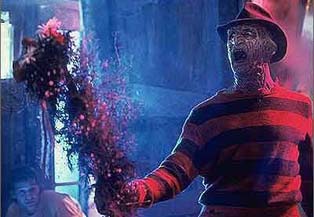Chapter Two:
A Nightmare on Elm Street Part 2: Freddy's Revenge
By Brett Beach
December 8, 2009
The original Elm Street remains both fairly un-campy and somewhat disturbing. This is because time hasn't diminished the genius conceit that Craven came up with: What if your dreams could kill you? What if sleeping wasn't something to be enjoyed but something to be feared? What if the Boogeyman wore an ugly sweater and could slice you open with his knife hands? The first Elm Street still feels like a waking dream/nightmare. It's very visceral, played fairly straight and even the moments of sunlight and (relative) happiness feel as if they're reflected off of impending clouds. The violence, particularly the brutal slaying of Tina, doesn't come with any jokey relief.
Of course, the key difference between Freddy and his slasher movie brethren is that he talked while they remained decidedly silent. And while the series became campy quite quickly beginning with the first sequel, consideration must be given for the fine line that Robert Englund walks with his performances. The lines may be campy, the circumstances may be campy, but Freddy never is. He is confident, quite smart and exceedingly cruel. In a way, I think there is a hint of Freddy in Heath Ledger's Joker – the delight in the chaos he brings to the world around him and his utter control of the situations he calls to life. Englund deserves all the praise he has gotten and continues to get for making Freddy such a diabolical and fascinating villain.
Interesting fact: In 1984, Wes Craven was against turning A Nightmare on Elm Street into a franchise and wanted nothing to do with the proposed sequel once the first film's popularity dictated that one would get made.
A Nightmare on Elm Street was a hit the way a lot of low-budget horror films of its era were. It never played in more than several hundred theaters at one time but moved around the country slowly and was in theaters from November of 1984 through the spring of 1985, grossing just over $25 million against a budget of under $2 million. This was the first breakout commercial success for independent studio New Line Cinema (R.I.P.) and led to the oft-repeated maxim that New Line was "The House that Freddy Built."
Freddy's Revenge followed this pattern explicitly, opening almost a year to the day after the first film in the fall of 1985. It debuted in twice as many theaters (almost 300!) and thus had an opening weekend about twice as large as the first Nightmare (nearly $3 million!). It went on to play well into the New Year and accomplished something that a lot of its horror ilk has never done: it grossed more than the first film did, finishing at just shy of $30 million. In real unadjusted dollars, it also out-grossed Friday the 13th Part 2 and Halloween II. Both of these feats are quite surprising given that: Freddy's Revenge doesn't feel like that much of a sequel to the first film; is generally considered to be one of the lesser installments in the long-running series; maintains a predominantly campy tone on several levels; and breaks a lot of the rules about how horror sequels are supposed to function. Oh, and then there's the part where the film functions primarily as an allegory for a young gay male's attempts to come to terms with his homosexuality. But I wouldn't want to get ahead of myself. Let's consider each of these angles in slightly more detail.
Continued:
1
2
3
4

![]() Tweet
Tweet
![]() Print this column
Print this column



